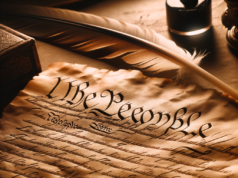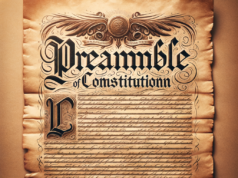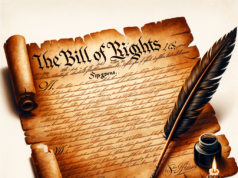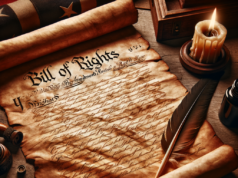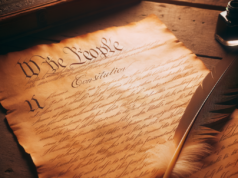Table of Contents
- 1 Types of Constitutional Amendments
- 2 Formal Constitutional Amendment Process
- 3 Informal Constitutional Amendment Process
- 4 Amendments of the US Constitution
- 4.1 The First Amendment
- 4.2 The Second Amendment
- 4.3 The Third Amendment
- 4.4 The Fourth Amendment
- 4.5 The Fifth Amendment
- 4.6 The Sixth Amendment
- 4.7 The Seventh Amendment
- 4.8 The Eighth Amendment
- 4.9 The Ninth Amendment
- 4.10 The Tenth Amendment
- 4.11 The 11th Amendment
- 4.12 Twelve Amendment
- 4.13 The Thirteenth Amendment
- 4.14 The Fourteenth Amendment
- 4.15 The Fifteenth Amendment
- 4.16 The Sixteenth Amendment
- 4.17 The Seventeenth Amendment
- 4.18 The Eighteenth Amendment
- 4.19 The Nineteenth Amendment
- 4.20 The Twentieth Amendment
- 4.21 The Twenty-first Amendment
- 4.22 The Twenty-second Amendment
- 4.23 The Twenty-third Amendment
- 4.24 The Twenty-fourth Amendment
- 4.25 The Twenty-fifth Amendment
- 4.26 The Twenty-sixth Amendment
- 4.27 The Twenty-seven Amendment
- 4.28 Conclusion

Introduction
The US Constitution is the supreme law of the United States, and its amendments are positive changes made to it over time. The Constitution of the United States outlines the structure of the federal government, it’s responsibilities and role, and providing a framework for its operation. The Constitution was written to protect the rights of American citizens and ensure liberty and freedom for all. The framers had no doubt that it was not a perfect document and understood the need to add provisions through amendments for the ever-changing society. Constitutional amendments are alterations and changes introduced into the Constitution and are usually passed to address specific issues or concerns. This article will explain the constitutional amendments and how they have changed and impacted the US Constitution.
Background
The Constitution of the United States was ratified in1788, and it included ten amendments that were ratified between 1789 and 1791, following its ratification. The first ten amendments of the Constitution are known as the Bill of Rights, and the rest is referred to as the additional amendments. The Bill of Rights provided the basic protections to the American citizens, including the protections of speech and religion and protecting Americans’ right to bear arms. The first ten amendments set the course of the future amendments that would be proposed to address any issues or concerns that arise in the society. Since ratification, there have been 27 amendments to the Constitution, with the most recent one ratified in 1992.
Types of Constitutional Amendments
Amendments to the US Constitution are presented for approval by Congress but must be ratified by the states to become part of the Constitution. There are two ways to initiate a constitutional amendment process, via the Congress or through a constitutional convention. However, only the Congress method has been used to date. A constitutional amendment exists in two forms: the formal and informal. The formal constitutional amendment process includes the proposal, ratification, and incorporation process, while the informal amendment process does not require a formal proposal or ratification process.
Formal Constitutional Amendment Process
The formal amendment process is undertaken according to the procedures stipulated in the Fifth Article of the US Constitution. The amendment proposed by Congress is adequate for states’ ratification, and the states select delegates to represent them. The required threshold for the ratification of a proposed amendment is two-thirds of both the House of Representatives and the Senate and must be approved by the President. However, the people’s voice was incorporated in the amendment process, making the amendment process lengthy and tedious. The strict requirements in the amendment process act as a safeguard measure in the US Constitution.
Informal Constitutional Amendment Process
The informal amendment process is the process by which interpretations and the application of the Constitution are altered. The informal amendment process does not effectuate a formal amendment, as the US Constitution remains unaltered; instead, there is an assigned interpretation or application. The informal amendment process is commonly referred to as a living Constitution, as its interpretations are subject to change with the evolving society.
Amendments of the US Constitution
The First Amendment
The First Amendment of the US Constitution was ratified on December 15, 1791. It established the separation of church and state, individual liberties, and freedom of speech of the people. The First Amendment protects the people’s right to freedom of speech, religion, assembly, and petition. Essentially, it protects your right to say or write anything, even if it is controversial or unpopular, without fear of retaliation, and the government cannot establish a religion. The First Amendment guarantees that all people may practice their chosen religion, and the government is prohibited from establishing or directing religious practices.
The Second Amendment
The Second Amendment was ratified in 1791, and it guaranteed American citizens the right to bear arms, as well as the right to form a militia. Americans have long argued about the interpretation of the Second Amendment. Those who fought for gun control and restriction believed that this amendment was outdated, while those against it believed that this amendment afforded a measure of protection for American citizens. The interpretation of the Second Amendment illustrates the amendment process in action, as it is subject to interpretation by subsequent generations.
The Third Amendment
The Third Amendment was ratified in 1791 and states that no American citizen shall be required to quarter soldiers in their home during times of peace. This amendment primarily ensures that no standing armies could be enforced in civilian settlements without permission.
The Fourth Amendment
The Fourth Amendment was ratified in 1791 and offers protection against unreasonable searches and seizures. Law enforcement agencies must obtain a warrant before conducting a search or seizure on a citizen’s private property or person. The Fourth Amendment also protects citizens’ privacy against unreasonable intrusion from law enforcement.
The Fifth Amendment
The Fifth Amendment was ratified in 1791 and offers protection against self-incrimination, the right to due process of law, and the right to receive compensation for the seizure of public property. The right against self-incrimination ensures that citizens have the right to refrain from answering questions or providing information that the government can use to accuse them in court. The due process clause ensures that every citizen of the United States is given a fair trial before the law. The Fifth Amendment is the source of Miranda rights.
The Sixth Amendment
The Sixth Amendment was ratified in 1791 and guarantees every American citizen accused of a crime the right to a fair trial. This includes a public trial, an impartial jury, counsel, and an opportunity to confront their accusers. These provisions of the Sixth Amendment provide protection to citizens at the time of trial.
The Seventh Amendment
The Seventh Amendment was ratified in 1791 and ensures that any accused person has the right to a trial by jury when the value of the controversy exceeds $20. This amendment provides a right to a trial by a jury of one’s peers.
The Eighth Amendment
The Eighth Amendment was ratified in 1791 and prohibits excessive fines and bails and cruel and unusual punishment. This amendment serves as a check over the government’s power during sentencing and the court’s imposition of punishment.
The Ninth Amendment
This amendment was ratified on December 15, 1791. It guarantees American citizens the rights not specifically listed in the Bill of Rights and that the government should respect the people’s inalienable rights.
The Tenth Amendment
The Tenth Amendment was ratified in 1791 and assigns all powers not explicitly awarded to the federal government, the states, or the people. This amendment ensures that the power of the central government is limited and the remaining power is assigned to the states and the people.
The 11th Amendment
The 11th Amendment was ratified on February 7, 1795, and forbids federal courts from hearing cases in which states are sued by citizens of other states. This amendment shields states from litigation by private citizens in federal courts.
Twelve Amendment
The Twelfth Amendment was ratified on June 15, 1804. The amendment altered the way presidential elections were conducted in America. Before this amendment, presidential electors cast two votes for the presidency, one of which may be cast for a candidate outside their state. However, after an amendment garnered majority support of electoral votes, a single vote was given to the presidential candidate, and the runner-up became the vice president.
The Thirteenth Amendment
The 13th Amendment was ratified on December 6, 1865 and abolished slavery or involuntary servitude, except as a punishment for a crime. The Thirteenth Amendment was a vital change to the US Constitution as it made slavery illegal. However, Many southern states used “convict leasing” as a tool to continue African American slavery for another century, which led to the implementation of further amendments.
The Fourteenth Amendment
The 14th Amendment was ratified on July 9, 1868, and established equal protection for citizens of the United States, as well as due process of the law. The 14th Amendment also made every person born or naturalized in the United States a citizen.
The Fifteenth Amendment
The Fifteenth Amendment was ratified on February 3, 1870, and provided African American males the right to vote. The Fifteenth Amendment was a significant change to the US Constitution as it extended the vote to a greater number of African Americans.
The Sixteenth Amendment
The 16th Amendment was ratified on February 3, 1913. It introduced an Income Tax to the American tax system. The 16th Amendment allows the federal government to tax income from all sources, including salaries and wages, as well as unearned income.
The Seventeenth Amendment
The Seventeenth Amendment was ratified on April 8, 1913, and introduced popular election of Senators. Previously, Senators were elected by State Legislators, but the Seventeenth Amendment specified that Senators were to be elected from each state by popular vote.
The Eighteenth Amendment
The 18th Amendment was ratified on January 16, 1919, and banned the sale, transport, or manufacture of alcohol in the United States. Prohibition was introduced to reduce crime and improve moral integrity.
The Nineteenth Amendment
The 19th Amendment was ratified on August 18, 1920 and granted women the right to vote. The Nineteenth Amendment was instrumental in providing equal rights to women and putting an end to gender discrimination.
The Twentieth Amendment
The 20th Amendment was ratified on January 23, 1933, and shortened the lag time between Election Day and the start of presidential and congressional terms.
The Twenty-first Amendment
The 21st Amendment was ratified on December 5, 1933, and repealed the 18th Amendment, ending the prohibition of alcohol in the United States.
The Twenty-second Amendment
The 22nd Amendment was ratified on February 27, 1951, and sets term limits for the President. A President cannot be elected to more than two terms.
The Twenty-third Amendment
The 23rd Amendment was ratified on March 29, 1961, and granted residents of Washington, D.C., the right to vote in presidential elections.
The Twenty-fourth Amendment
The 24th Amendment was ratified on January 23, 1964, and banned the use of poll taxes in federal elections.
The Twenty-fifth Amendment
The 25th Amendment was ratified on February 10, 1967, and outlines Presidential succession and the incapacitation of the President. The amendment provides a clear line of succession if the President is unable to serve.
The Twenty-sixth Amendment
The Twenty-sixth Amendment was ratified on July 1, 1971, allowing 18-year-old citizens of the United States the right to vote. This amendment provided suffrage to a younger group of Americans and increased their political power.
The Twenty-seven Amendment
The 27th Amendment was ratified on May 7, 1992, and governs Congressional pay. Until this amendment, Congress was free to determine its salary, which raised concerns about abuse of power.
Conclusion
The US Constitution serves as the foundation upon which American democracy is built. The Constitution has undergone numerous changes in the form of Constitutional Amendments since its inception in 1789, adjusting its provisions to meet societal and governmental changes. The Amendments alter the constitutional provisions and ensure Americans of their freedom and proper representation. The US Constitution, including its amendments, is the most significant legal doctrine in America, guiding federal and state laws while providing fundamental rights to every American citizen. The US Constitution remains a living document, though, which can morph to reflect an ever-changing society.
Constitutional Amendments are changes that can be made to the United States Constitution. The Constitution itself is the governing doctrine in which all the rights and privileges afforded to citizens of the United States are listed. Furthermore, the U.S. Constitution outlines the restrictions and regulations that are put against the Government in order to preserve the rights of the citizens.
When it comes to the current Constitutional Amendments, all 27 Amendments have been implemented through the process of voting and installing them. Out of all 27 Amendments, only one has been repealed: the 18th Amendment, known as the Prohibition Amendment regulating the manufacturing and distribution of alcohol and high-proof spirits. However, in 1933, the 21st Amendment was voted in, which repealed the Prohibition Amendment.
The first Ten Amendments, which are the most well-known, are called the Bill of Rights. Each Constitutional Amendment in the Bill of Rights is one that was imposed to give natural rights to individuals. Rights such as the freedom of speech and press, the right to bear arms, and the right to not incriminate oneself during a trial, along with the right to have a trial, are among the first Ten Amendments implemented. Some of these have been expanded further by the implementation of other Amendments, while others are merely regarded when it comes to legal issues and infringement of rights.
Overall, the Constitutional Amendments are important because they are voted on by Congress and the states to implement and further give rights to the citizens of the United States.



